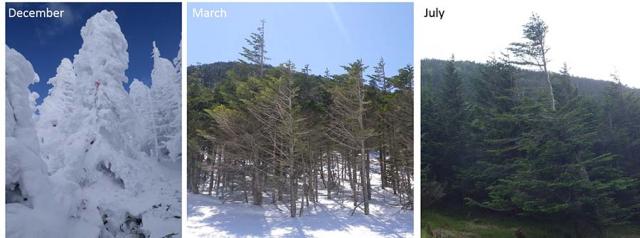Home > Research > Research Results > Research Results 2019 > Water-flow blockage in the branches of the subalpine conifer Veitch's silver fir (Abies veitchii) is repaired by summer
Update:October 2, 2019
Main content starts here.
Water-flow blockage in the branches of the subalpine conifer Veitch's silver fir (Abies veitchii) is repaired by summer
| Article title |
Repair of severe winter xylem embolism supports summer water transport and carbon gain in flagged crowns of the subalpine conifer Abies veitchii |
|---|---|
| Author (affiliation) |
Mayumi Y. Ogasa (a), Haruhiko Taneda (b), Hiroki Ooeda (b), Akihiro Ohtsuka(b)、Emiko Maruta(c) (a) Kansai Research Center, FFPRI, Kyoto, Japan. (b) The University of Tokyo, Tokyo, Japan. (c) Kanagawa University, Kanagawa. Japan. |
| Publication Journal |
Tree Physiology、Oxford、June 2019 DOI:10.1093/treephys/tpz066( External link ) |
| Content introduction |
The branches of evergreen conifers growing in subalpine and alpine zones experience strong winds, heavy snow, low temperature, and soil freezing during winter. These conifers are continuously subjected to stress imposed by drought for several months until the spring season. During early spring, water within the conduits in the branches cycles between freezing at night and thawing during the day. This causes the xylem (water-conducting vascular channel) to clog with air bubbles, and the embolism prevents the water flow in the branches. However, it has not been revealed whether the branches overcome this stress and recover during the growing period in the following summer. We studied the subalpine conifer Veitch's silver fir (Abies veitchii) and compared the windward and leeward branches. It was found that until sprouting in July, branches on both sides recover from the stress due to drought and xylem embolism. Our results also showed that sufficient photosynthesis occurred even in the leaves of the trees on the windward side, regardless of leaf age. It is considered that evergreen conifers in the subalpine and alpine zones have evolutionarily acquired this function to cope with severe weather conditions in winter and grow in short summer. Understanding the mechanisms of plant survival in such severe environments will be beneficial in predicting their possible adaptability to the shifting environment, including global warming, as well as predicting changes in the future distribution of the species.
photo:Abies veitchii on Mt. Shimagare (located in the northern Yatsugatake Mountains in central Japan) in December, March, and July (The photo taken in July was provided by Dr. Haruhiko Taneda from The University of Tokyo). |
Copyright © Forest Research and Management Organization. All rights reserved.

